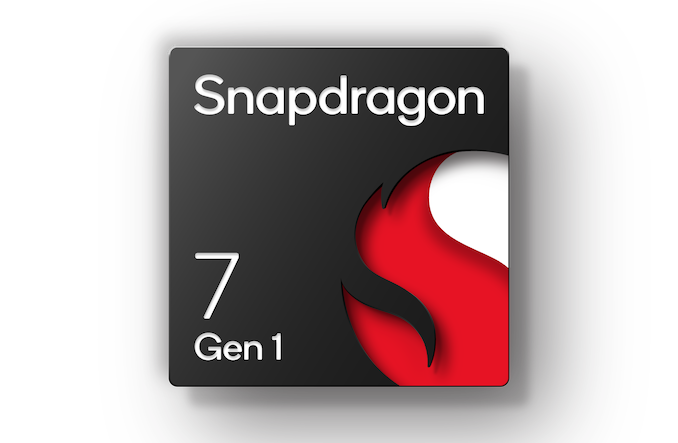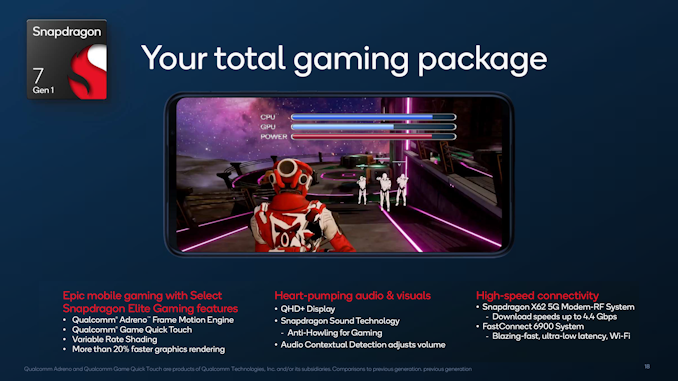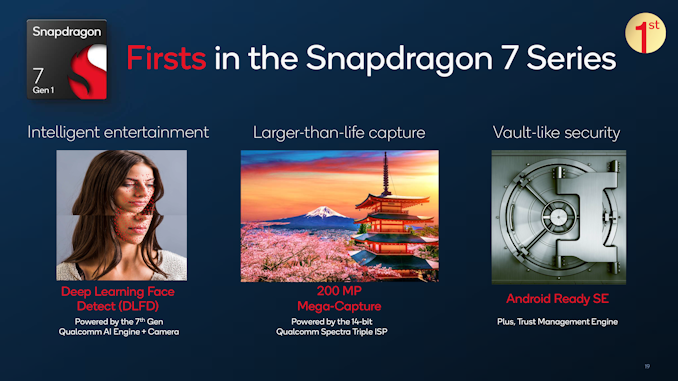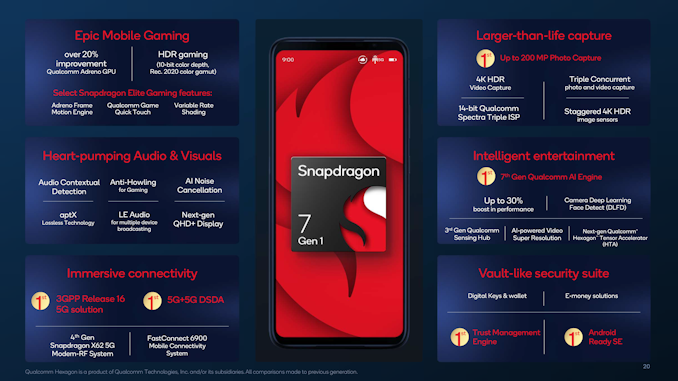Qualcomm Announces Snapdragon 7 Gen 1: Bringing Armv9 To Premium Smartphones
by Ryan Smith on May 20, 2022 10:30 AM EST- Posted in
- Mobile
- Qualcomm
- Smartphones
- SoCs
- ARMv9
- Snapdragon 7 Gen 1

Alongside the new Snapdragon 8+ Gen 1, as part of Qualcomm’s “Snapdragon Night” event in China this evening, the company is also rolling out a brand-new SoC for the premium phone market, the Snapdragon 7 Gen 1. Aimed downmarket of Qualcomm’s traditional flagship SoCs, the Snapdragon 7 Gen 1 is the first non-flagship SoC to be introduced by Qualcomm since they implemented their new platform naming and differentiation scheme. But, like the Snapdragon 7xx series before it, the latest Snapdragon 7 SoC follows the same design mantra of offering flagship-level features with more modest performance and costs.
Within Qualcomm’s pantheon of smartphone SoCs, the Snapdragon 7 Gen 1 is the successor to last year’s Snapdragon 780G/778G parts. For the moment, Qualcomm is sticking with a single SKU, though last year the 780G and 778G were a few months apart – so Qualcomm may bifurcate things farther down the line.
Like its predecessors, the 7 Gen 1 follows Qualcomm’s cascading development strategy, which sees new features first pioneered in their flagship SoC successively implemented in future, lower-tier chips. The big update on the Snapdragon 8 Gen 1 was of course the switch to the Armv9 architecture and Arm’s associated CPU cores, and now Arm’s premium tier SoC is getting the same treatment.
| Qualcomm Snapdragon 7-Class SoCs | |||
| SoC | Snapdragon 7 Gen 1 | Snapdragon 780G | |
| CPU | 1x Cortex-A710 @ 2.4GHz 3x Cortex-A710 @ 2.36GHz 4x Cortex-A510 @ 1.8GHz |
1x Cortex-A78 @ 2.4GHz 3x Cortex-A78 @ 2.2GHz 4x Cortex-A55 @ 1.9GHz |
|
| GPU | Adreno | Adreno 642 | |
| DSP / NPU | Hexagon | Hexagon 770 | |
| Memory Controller |
2x 16-bit CH @ 3200MHz LPDDR5 / 25.6GB/s |
2x 16-bit CH @ 2133MHz LPDDR4X / 17.0GB/s |
|
| ISP/Camera | Triple 14-bit Spectra ISP 1x 200MP or 84MP with ZSL or 64+20MP with ZSL or 3x 25MP with ZSL 4K HDR video & 64MP burst capture |
Triple 14-bit Spectra 570 ISP 1x 192MP or 84MP with ZSL or 64+20MP with ZSL or 3x 25MP with ZSL |
|
| Encode/ Decode |
4K30 10-bit H.265 Dolby Vision, HDR10+, HDR10, HLG 720p480 infinite recording |
4K30, 1080p120 H.264 & H.265 10-bit HDR pipelines |
|
| Integrated Modem | X62 Integrated (5G NR Sub-6 + mmWave) DL = 4400 Mbps |
X53 Integrated (5G NR Sub-6 4x4 100MHz) DL = 3300 Mbps |
|
| Mfc. Process | Samsung 4nm | Samsung 5LPE | |
In terms of organization, the new 7 Gen 1 is very similar to the 780G, implementing a 1+3+4 core configuration. Qualcomm is only using two core types here – the high-performance Cortex-A710 and high-efficiency Cortex-A510 – so rather than the prime core being a unique core type (ala the Cortex-X2 on the 8G1), it’s another Cortex-A710 here. Qualcomm is clocking this core at 2.4GHz, meanwhile the remaining 3 A710s are clocked a bit lower at 2.36GHz. Finally, the A510s come clocked at 1.8GHz, the same as on the 8G1.
The shift in CPU cores also brings an update to Qualcomm’s memory controller. The 7 Gen 1 adds LPDDR5 capabilities, supporting up to the same LPDDR5-6400 data rates as the 8 Gen 1. So with a 2x16-bit channel memory bus, the 7 Gen 1 can access up to 25.6GB/second of memory bandwidth, a 50% improvement over the LPDDR4X-capable 780G.
Unusual even for Qualcomm, the company isn’t talking about CPU performance with the new part. So absent benchmarking data, there’s little we can say here about performance expectations. The new Arm cores should allow for better performance, but there’s a lot of wiggle-room due to implementation details.
Meanwhile Qualcomm is being a bit more talkative on the GPU front, though not immensely so. Like the 8G1, Qualcomm is dropping any kind of model number for the GPU on the 7 Gen 1, so it’s simply “Adreno” with nothing to differentiate it from the 8G1 or previous-generation parts. Technically, we can’t even infer whether it uses Qualcomm’s new GPU architecture – though given the feature set and cascading design strategy, it’s almost certainly yes. But what Qualcomm is saying about the GPU performance of the new part is that it’s 20% faster than the Snapdragon 778G and it’s Adreno 642L GPU. By going with the weaker SKU, this is cherry picking by Qualcomm, but for now it at least confirms that the 7 Gen 1 will be somewhat faster than its predecessor.
Which is a good thing, too, since gaming is one of the major focuses of the 7 Gen 1. It’s gaming/GPU performance that Qualcomm leads with in their 7 Gen 1 marketing materials, and it’s no coincidence that this part is being announced at an event in China. Mobile gaming is big across the globe, but nowhere is it bigger than the Chinese market. So Qualcomm is undoubtedly expecting their OEM partners to shift a significant number of gaming-focused handsets in that busy market.
Meanwhile, since this isn’t a flagship part like the new 8+ Gen 1, Qualcomm isn’t being as aggressive on the fab front, either. The 7 Gen 1 is being produced on Samsung’s 4nm process, the same one as the original 8 Gen 1, and which Qualcomm is intentionally supplanting with TSMC for their flagship SoC. And while Samsung’s process is clearly the lower performing option at this juncture, with lines at TSMC running out the door and around the block, it’s not surprising to see Qualcomm opt for what is a less constrained (and undoubtedly cheaper) fab for their second-tier smartphone SoC.
CPU and GPU matters aside, Qualcomm’s cascading design strategy also means a few other notable features from the 8G1 are moving down to their new 7-series SoC. That includes the newest Spectra ISP, as well as Qualcomm’s latest AI hardware and their trust management engine.
In the case of the 7 Gen 1’s Spectra ISP, it has been scaled down accordingly from the 8G1. Qualcomm is still implementing a “triple” ISP here that can handle up to 3 simultaneous cameras, however total throughput is lower. Still, the ISP can handle up to a 200MP image now, though that drops significantly to 64MP if you need zero shutter lag. Past that, this is another 14-bit imaging pipeline ISP, which is on-par with the 780G, but lacks the additional dynamic range of the 8G1.
Rounding out the package is an integrated modem, in the form of Qualcomm’s Snapdragon X62. Compared to last year’s 780G SoC and its X53 modem, the X62-equipped 7 Gen 1 offers both greater throughput and more bands. In particular, this SoC is mmWave capable, which was a notable omission from last year’s SoC. Altogether, the 7G1/X62 is capable of reaching download speeds up to 4.4Gbps, a 33% improvement over its predecessor.
Wrapping things up, the Snapdragon 7 Gen 1 will be the quicker to ship of Qualcomm’s two new SoCs today. According to the company, handsets using the SoC will be available this quarter, with Honor, OPPO, and Xiaomi among the OEMs slated to release phones based around the new chip.













22 Comments
View All Comments
Ryan Smith - Friday, May 20, 2022 - link
The prime core in Qualcomm's architectures is on its own clock plane. And it often has more cache, as well (though we don't have those figures for this part right now). So 1+3+4 is accurate.Dante Verizon - Friday, May 20, 2022 - link
Probably no big performance gain over the 778G/780.Kangal - Sunday, May 22, 2022 - link
Actually I'm fairly impressed.The QC 7g1 should be slightly ahead of the QSD 870. So if this chipset is overclocked, it can surpass the QSD 888+ and also the QC 8g1. However, I am not a fan of such high-voltage chipsets in phones, I want them to be Warm, Passively Cooled, and requiring a smaller battery.
This feels like the right chip in the right spot. The QSD 778 and QSD 780 were a huge revolution, I figured they would finally match/surpass the QSD 845 but they ended up bringing QSD 855/855+/860 levels to budget options. And the QC 7g1 extends that. The midrange segment has been stuck on the QSD 720-QSD 768G level of performance (QSD 835) for too long.
I would be pretty happy to have this chipset in my phone, especially if it means that I am paying for USD $500 price instead of a USD $999 price. Just look at the Samsung A52-s, they discontinued that as fast as possible because it was threatening their luxury options.
iphonebestgamephone - Sunday, May 22, 2022 - link
It might match 870 in cpu performance, but the gpu being only 20% faster than 778g's 642L means its only going to be on par with 855's adreno 640. Prolly gonna be a lot more efficient tho. While d8100's mali is on par with 888's adreno 660. 7 gen 1 is on the samsung node with a710 cores i wont be expecting too much.Kangal - Sunday, May 22, 2022 - link
The QSD 780 had a slightly faster GPU than the QSD 855+ and slightly below the QSD 860. Basically on-par with the QSD 860. The QSD 778 basically uses the same setup.Adding 20% on top of it, should make it at least QSD 865 territory. But it's likely it will be QSD 870 level. But it really depends on the device. Some have drivers that perform faster than others, and it helps if the device is large and was designed with cooling in mind. Pretty big gap in performance sometimes.
Even if the MediaTek chipset is technically superior, I would rather Qualcomm. For one thing, I won't be supporting a company that has GPL violations, secondly it means custom firmware can be an option, and lastly it will have much more stable software (eg AetherSX2 and Dolphin performance between Adreno vs Mali is huge).
iphonebestgamephone - Monday, May 23, 2022 - link
855+ and 860 are the same thing in cpu and gpu perf. 780g matches 855+ gpu. 778g is worse. 855 is 20% faster than it. 865 is 25% faster than 855. Drivers are all the same for same chipset, getting updates faster is the only difference.Dolphin has improved on mali a lot, its pretty much similar to adreno now, though a few games might have problems. Citra too runs very well, though graphic glitches might be even more than dolphin. Right now its aether and skyline(maybe eggns too) that adreno is clealry superior in.i would get a snapdragon too for the same reasons, but these are just niche usecases.
Captain obvious - Saturday, May 21, 2022 - link
Qualcomm probably compared against the 778 because the 780 was only used on a single phone before being quietly discontinued.I guess they cancelled it in favour of more 5lpe wafers for the 888, and used almost the same blocks on the 778g using tsmc n6.
Wereweeb - Saturday, May 21, 2022 - link
Any word on whether the security features are comparable to the SD8G1's?brucethemoose - Sunday, May 22, 2022 - link
Still no AV1 decode.That's expected, since the 8 doesn't have it, but I have to wonder how long Qualcomm is gonna hold out.
Also, it makes me *really* not want a Qualcomm 7/8 device, since I tend to keep them for a long time and maybe hand them down.
patel21 - Monday, May 23, 2022 - link
Yes, Doesn't make sense for me to buy a new device this/next year without AV1 support as I too keep devices for 4-5 years. I'd rather go for a Dimensity device with AV1 support